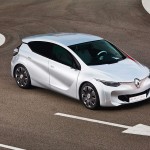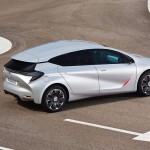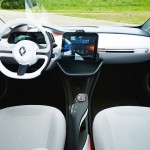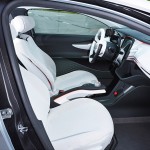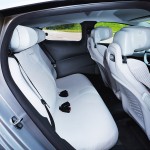Renault’s new EOLAB concept is an environmental prototype with nearly 100 technological innovations, all designed to deliver ultra-low fuel consumption. How low? Just one litre per one hundred kilometres – or 282mpg and emits a mere 22g/km CO2 (NEDC)! Despite the achievement of ‘most frugal’, Renault have ensured the concept maintains established B-segment levels of performance, practicality and affordability, though the latter is naturally up for debate since the price is yet to be announced. However, Renault have gone to great lengths to explain their design for EOLAB swayed away from the obvious choice of luxurious lightweight materials and instead aimed to keep costs at a minimum and to use less exotic materials. Jean-Pierre Fouquet, Z.E. Hybrid Innovation Project Leader states,
“Today, most of the market’s hybrid vehicles are higher segment cars with a price tag of more than €40,000. The solutions showcased by EOLAB are much more economical and enable hybrid technology to be used for smaller cars and on a much bigger scale. Our objective is to produce a car with two power sources for the price of one.”
To achieve the remarkable CO2 and MPG values, Renault’s designers focused their efforts on three main areas: minimising weight, refining aerodynamics and using “Z.E. Hybrid” technology; a brand new initiative which permits zero emissions motoring during everyday use by allowing for a 41 miles (66km) electric only range. The EOLAB is also a plug-in hybrid, allowing owners to treat their vehicle as an electric car for most of their local journeys and only using the range extending 3-cylinder petrol unit at times when they want to go that much further.
Renault state that EOLAB’s high number of technological advances are destined to be carried over gradually to other vehicles available in their showrooms. Consequently, EOLAB underlines the undertaking of Renault to take even greater steps to produce affordable models that have an increasingly smaller carbon footprint. It is likely therefore that styling elements seen on the EOLAB may make their way to the next generation of ZOE electric cars and others in the Renault range.
The EOLAB derives its name from both Greek mythology (Aeolous, God and ruler of Wind) and “Laboratory”. Scheduled to have its World Premiere at the 2014 Paris Motor Show on 2 October, EOLAB not only previews innovative technology that is destined to be introduced on production Renaults from now until 2020 but also the vision of such a realistic B-segment car that will appear within 10 years.
EOLAB: Overview
- Around 100 new, realistic technological developments designed to be introduced gradually on new production Renaults from now until 2020
- Aerodynamics of 0.235 Cd (30 per cent less than equivalent Clio)
- Active ride height: Access mode, Urban mode and Extra-Urban mode
- Active wheels – react to brake temperature to maximise Cd
- Active front spoiler
- Active rear flaps
- Weight savings across the entire vehicle (400kg over equivalent Clio)
- Asymmetric 3-door layout
- Compact revised brakes – no master cylinder & all systems integrated into one small lightweight unit
- Narrow 145/45R17 Michelin ultra-low consumption tyres
- Ultra-thin windscreen glass (3mm) – saves 2.6kg
- Thinner interior trim & lighter plastics containing air bubbles
- Optimised seat structures – save 12kg and 30mm in car length
- Lightweight dashboard cross member
- Lighter running gear – steel to aluminium
- Magnesium roof weighs just 4.5kg
- Brakes are 14.5kg lighter but retain the same braking efficiency
- Fixed bonnet gains 2.5kg
- LED front lights
- Lithium –ion battery
- Compact centre-exit exhaust system to save weight
- 100% Renault Z.E. Hybrid powertrain
- 1.0-litre 3-cylinder 75hp SCe petrol engine
- 400V, 6.7 kWh battery with 41 miles (66km) range
- Innovative patented clutchless 3-gear transmission
- Human Machine Interface – connectivity and real-time eco-driving information
Source; Renault
